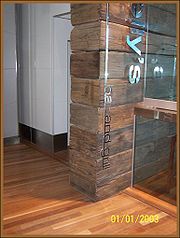
Timber recycling
Encyclopedia

Waste
Waste is unwanted or useless materials. In biology, waste is any of the many unwanted substances or toxins that are expelled from living organisms, metabolic waste; such as urea, sweat or feces. Litter is waste which has been disposed of improperly...
timber
Timber
Timber may refer to:* Timber, a term common in the United Kingdom and Australia for wood materials * Timber, Oregon, an unincorporated community in the U.S...
into usable products. Recycling timber is a practice that was popularized in the early 1990s as issues such as deforestation and climate change, prompted both timber suppliers and consumers to turn to a more sustainable timber source. Recycling timber is the most environmentally friendly
Environmentally friendly
Environmentally friendly are terms used to refer to goods and services, laws, guidelines and policies claimed to inflict minimal or no harm on the environment....
form of timber production and is very common in countries such as Australia and New Zealand where supplies of old wooden structures are plentiful. Timber can be chipped down into wood chips which can be used to power homes or power plants.
Benefits

Recycling one ton of wood saves 18,000,000 BTUs of heat energy
Drawbacks
Some hurdles facing the widespread adoption of recycled timber: Sometimes the ends of wall studs need to be trimmed off to stop decay and cracking, thus resulting in a shorter piece of wood; this trimming may result in pieces of wood that don't meet building codes. Though the price may be less than for new wood, the process of selecting usable pieces of salvaged wood, pulling out nails, and refinishing for a new use can be laborious and time-consuming. Demolition must happen in such a way as to preserve as much of the timber as possible in a building, which means more time spent dismantling a building rather than just tearing it down quickly. The trade in recycled timber is not well-established everywhere, so a reliable supply of usable wood may be hard to come by for builders. There may be a stigma associated with using "used" or "cheap" wood that is perceived to be of not as high quality as "new" wood. Not all pieces of wood in a dismantled building will fit in a new building, and it may be cheaper and easier, from a design and labor perspective, to simply get new wood (ex: wood from a 6 foot (1.8 m) deck being used in a 7 foot (2.1 m) deck). Of course, none of these issues are insurmountable, and they are issues of convenience and logistics rather than structural integrity, but many builders find it easier and less time-consuming to simply get new wood in standard uniform sizes.Recycling timber
Recycled timber most commonly comes from old buildings, bridges and wharfs, where it is carefully stripped out and put aside by demolishers. At the same time any usable dimension stoneDimension stone
Dimension stone is natural stone or rock that has been selected and fabricated to specific sizes or shapes. Color, texture and pattern, and surface finish of the stone are also normal requirements...
is set aside for reuse. The demolishers then sell the salvaged timber to merchants who then re-mill the timber by manually scanning it with a metal detector, which allows the timber to be de-nailed and sawn to size. Once re-milled the timber is commonly sold to consumers in the form of timber flooring, beams and decking.
Examples
Use of recycling timber is not new. As early as 1948, the 100 metres tall tower of Golm transmitterGolm transmitter
Golm transmitter was a mediumwave broadcasting facility on the area of a former military high school at Golm near Potsdam. It was inaugurated in 1948 as central transmitter for Brandenburg state....
near Potsdam, Germany was built from recycled timber. It stood for 31 years.
See also
- SawmillSawmillA sawmill is a facility where logs are cut into boards.-Sawmill process:A sawmill's basic operation is much like those of hundreds of years ago; a log enters on one end and dimensional lumber exits on the other end....
- RecyclingRecyclingRecycling is processing used materials into new products to prevent waste of potentially useful materials, reduce the consumption of fresh raw materials, reduce energy usage, reduce air pollution and water pollution by reducing the need for "conventional" waste disposal, and lower greenhouse...
- Nash TimbersNash TimbersNash Timbers is a global and domestic distributor of timber flooring, joinery, and beams.The company, based in Sydney, Australia, was founded in 2003 by David Nash...
- Natural buildingNatural buildingA natural building involves a range of building systems and materials that place major emphasis on sustainability. Ways of achieving sustainability through natural building focus on durability and the use of minimally processed, plentiful or renewable resources, as well as those that, while...
- LumberLumberLumber or timber is wood in any of its stages from felling through readiness for use as structural material for construction, or wood pulp for paper production....
- DenailerDenailerA denailer is a tool for removing nails from lumber to facilitate its reuse.Two types of denailer are available.-Portable:A portable denailer is a hand-held pneumatically-powered tool....
- Dimension stoneDimension stoneDimension stone is natural stone or rock that has been selected and fabricated to specific sizes or shapes. Color, texture and pattern, and surface finish of the stone are also normal requirements...
Stone recycling and reuse - Urban lumberjackingUrban lumberjackingUrban lumberjacking is a particular type of skipping or dumpster diving where the focus is to salvage wood either for home construction projects or for home heating.- Deliberate encouragement by businesses :...
External links
- Australian Recycled Timber
- Building Materials Reuse Association website, contains a directory of deconstruction contractors and reuse stores
- Construction Materials Recycling Association website, contains a directory of members, including some that recycle wood.
- Database of construction materials recyclers

